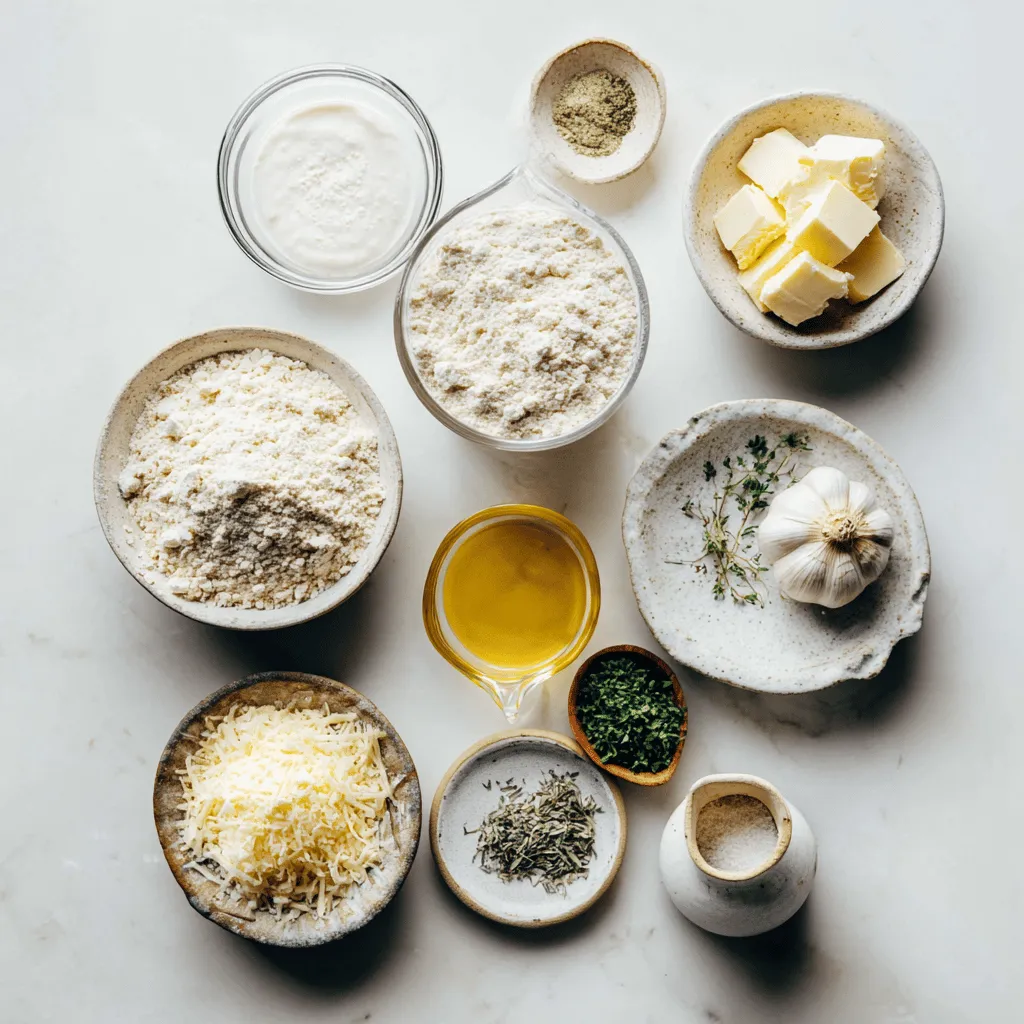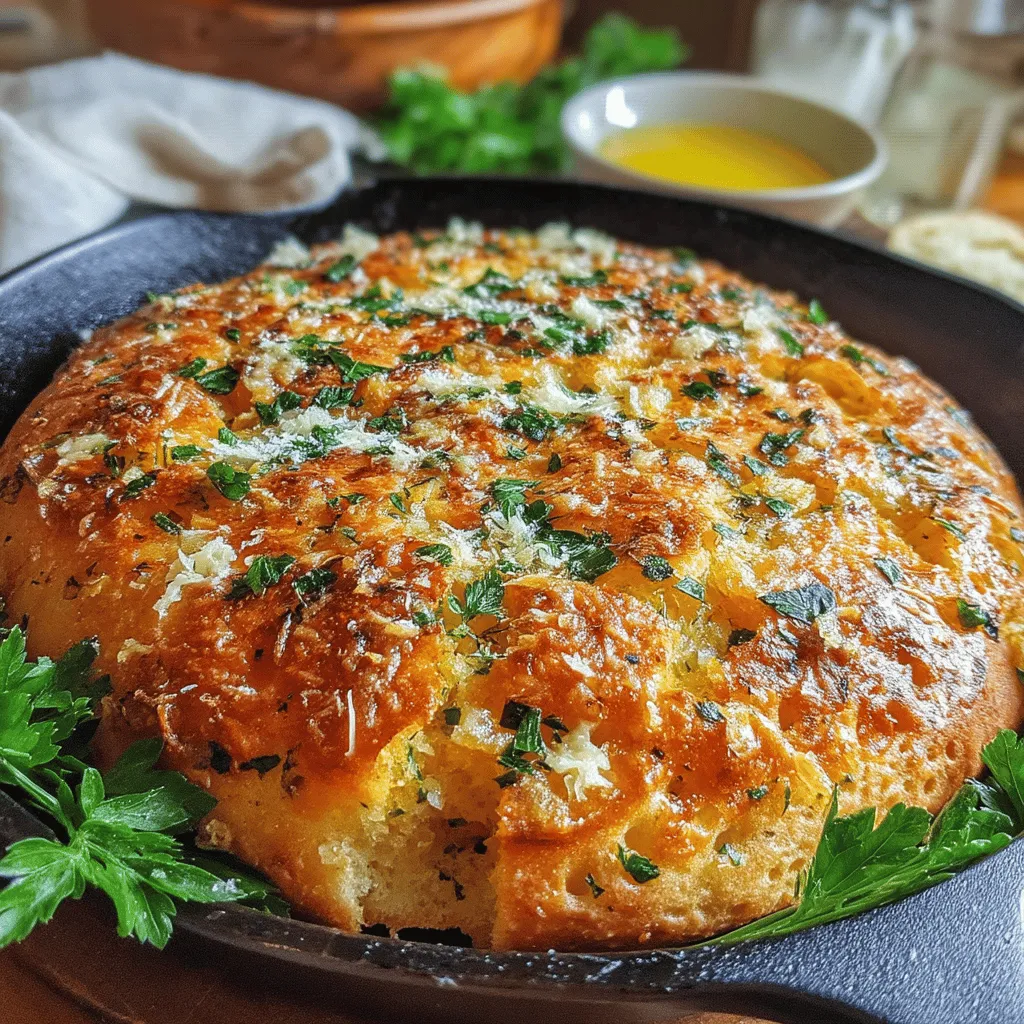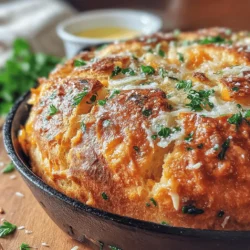Introduction
Homemade bread has been gaining popularity among food enthusiasts, and for good reason. The aroma of freshly baked bread fills the home with warmth and comfort, making it an irresistible treat. Among the various types of bread, savory garlic bread stands out for its versatility, complementing everything from pasta dishes to soups and salads.
Using whole wheat flour not only enhances the flavor but also provides a nutritious alternative to traditional white bread. This recipe for Savory Skillet Whole-Wheat Garlic Bread is designed to guide you through the process of making a delicious and healthy loaf that you can enjoy with family and friends.
In this article, you’ll find a detailed recipe along with insights into the preparation and benefits of using whole wheat flour.
Recipe Overview
– Total Time: 30 minutes
– Servings: 4
– Difficulty: Easy
Ingredients
– 2 cups whole wheat flour
– 1 tablespoon baking powder
– 1 teaspoon salt
– 1 tablespoon dried oregano
– 1 teaspoon garlic powder
– 2 cloves fresh garlic, minced
– 1 tablespoon fresh parsley, chopped
– 3 tablespoons unsalted butter, melted
– 3 tablespoons olive oil
– 1 cup water

Instructions
1. In a large mixing bowl, combine the whole wheat flour, baking powder, salt, dried oregano, and garlic powder.
2. Add the minced garlic and chopped parsley to the dry ingredients, mixing well.
3. In a separate bowl, whisk together the melted butter, olive oil, and water.
4. Gradually pour the wet mixture into the dry ingredients, stirring until a soft dough forms.
5. Transfer the dough to a floured surface and knead gently for a few minutes until smooth.
6. Preheat a skillet over medium heat and lightly grease it with olive oil.
7. Roll the dough into a flat circle that fits the skillet, about 1 inch thick.
8. Place the dough in the skillet and cover it with a lid. Cook for about 10 minutes on one side until golden brown.
9. Flip the bread carefully and cook for another 5–7 minutes on the other side.
10. Remove from the skillet, let it cool slightly, and serve warm.
Understanding Whole Wheat Flour
Whole wheat flour is made from the entire wheat kernel, which means it retains all parts of the grain—the bran, germ, and endosperm. This makes it a richer source of fiber, vitamins, and minerals compared to all-purpose flour.
In terms of nutrition, whole wheat flour boasts higher fiber content, which aids in digestion and promotes a feeling of fullness. It also contains essential vitamins such as B vitamins and minerals like iron and magnesium. Incorporating whole grains into your diet is vital for maintaining a balanced and healthy lifestyle.
Essential Ingredients Breakdown
Whole Wheat Flour
Whole wheat flour serves as the foundation of this recipe, providing both structure and nutrition. Its nutty flavor enhances the overall taste of the garlic bread while supplying essential nutrients.
Baking Powder and Salt
Baking powder is crucial for the dough’s rising, creating a light and airy texture. Salt not only enhances flavor but also plays a role in gluten development, improving the bread’s overall structure.
Herbs and Seasoning
Dried oregano and garlic powder add depth of flavor, while fresh garlic and parsley provide a burst of freshness and numerous health benefits. Garlic is known for its anti-inflammatory properties, while parsley is rich in vitamins A, C, and K.
Butter and Olive Oil
Fats like butter and olive oil are key to achieving the right texture and flavor in this garlic bread. They contribute to moisture and tenderness. When comparing unsalted butter and olive oil, olive oil is a healthier option, offering heart-healthy fats.
Optional Ingredients
Parmesan cheese can be added for an extra layer of flavor, though dietary considerations may vary. It adds a savory richness that complements the garlic and herbs beautifully.

Preparing the Dough
Mixing Dry Ingredients
Start by gathering your whole-wheat flour, baking powder, salt, and any desired herbs. In a large mixing bowl, combine these dry ingredients thoroughly. To create a well, push the dry mixture to the sides of the bowl, forming a small depression in the center. This will help incorporate the wet ingredients more effectively.
Achieving the Right Dough Consistency
When preparing your dough, it’s crucial to achieve the right consistency. The dough should be slightly sticky but manageable. If it feels too dry, gradually add water, a tablespoon at a time. Conversely, if it’s overly wet, sprinkle in a little more flour. Remember, the final texture should be soft and pliable but not overly sticky.
Incorporating Wet Ingredients
Mixing Techniques
When adding wet ingredients such as olive oil and water, pour them into the well you created in the dry ingredients. Use a fork or your hands to mix gently, ensuring an even distribution. Avoid overmixing, as this can lead to tough bread.
Knowing When the Dough is Ready
The dough is ready when it holds together and pulls away from the sides of the bowl without leaving too much residue. To test its texture, press your finger into the dough; it should spring back slightly, indicating that it has developed some structure.
Cooking Techniques
Preheating the Skillet
For perfect browning, preheat your skillet over medium heat for about 5 minutes before adding the dough. This will create a nice crust while ensuring the inside cooks properly. A drop of water should sizzle on contact to indicate the right temperature.
Cooking Instructions
Once the skillet is hot, place the dough in the center and flatten it gently. Cook for about 5-7 minutes on one side. Use a timer to manage your cooking time effectively. After this, cover the skillet with a lid for another 4-5 minutes to help the bread cook through without burning.
Flipping the Bread
Flipping the bread can be tricky. Use a large spatula to slide under the bread carefully. Lift it with both hands and flip quickly to avoid breaking it. If you’re concerned about it falling apart, you can cut the bread into quarters before flipping.
Serving Suggestions and Variations
Garlic bread serves beautifully alongside a range of dishes. Pair it with hearty soups, fresh salads, or serve it as an appetizer with dips like marinara or a roasted red pepper spread.
Variations to the Basic Recipe
Feel free to customize your garlic bread with additional ingredients. Mix in chopped fresh herbs like rosemary or thyme for an aromatic touch, or sprinkle in grated cheese like parmesan for extra flavor. You can also experiment with spices such as chili flakes for a bit of heat.
Dips and Spreads
Complement your savory garlic bread with dips such as hummus, pesto, or olive tapenade. These pairings enhance the flavor profile and provide a delightful contrast to the warm, garlicky bread.
Health Benefits of Homemade Bread
Making bread at home comes with numerous advantages over store-bought varieties. You have complete control over the ingredients, allowing for modifications to meet dietary restrictions, such as gluten-free alternatives or the inclusion of seeds and nuts for added nutrition.
Nutritional Control
When baking at home, you can adjust the recipe to suit your nutritional needs. For example, substitute all-purpose flour with whole grains or add seeds for extra fiber. This flexibility promotes healthier eating habits.
Psychological Benefits
Baking is not only a practical skill but also a form of therapy. The process can reduce stress and boost creativity, making it a rewarding hobby that benefits both your mental and physical well-being.
Conclusion
In summary, this savory skillet whole-wheat garlic bread offers a delightful blend of flavor and health benefits. Embracing homemade bread-making allows you to control ingredients and indulge in the therapeutic aspects of baking.
Feel encouraged to experiment with different variations to discover your favorites. There’s immense joy in sharing your creations with loved ones, making every loaf a memorable experience. Embrace the art of bread-making and enjoy the wholesome satisfaction it brings to your table.

